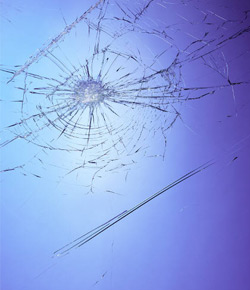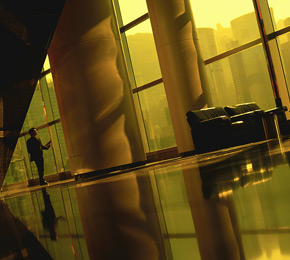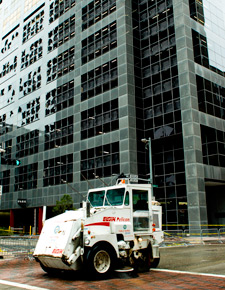Laminated Glass 101
- Overview
- Security - Forced Entry
- Security - Ballistics
- Decorative Glass
- Solar Control
- Security - Blast
- Safety
- Sound Control
Laminated Safety Glass Overview
Laminated architectural glass is manufactured by bonding a polyvinyl butyral (PVB) plastic interlayer between two pieces of glass under heat and pressure. The result is a single unit that appears transparent like ordinary glass but has many advantages:
The Forced Entry Qualities of Laminated Glass

Laminated Glass scores very high
in forced entry tests.
Forced Entry Performance
Security glazing is considered the ability of the glazing material to deter, slow or prevent penetration through an opening. Laminated glass can be manufactured to prevent the following:
Forced Entry:
Laminated glass will help protect residential and commercial buildings against forced entry. It will resist repeated blows from hammers, crowbars, rocks, bricks, etc. This greatly increases the time it takes an intruder to gain entrance, improving the chances that the intruder will move on to the next easier target. Using either heat strengthened or tempered glass will make the laminated unit up to four times stronger. Glass clad polycarbonates give greater protection against forced entry.
The Superior Ballistics Properties of Impact Resistant Laminated Glass

The ballistic impact performance of laminated
glass rates very high.
Laminated glass can be manufactured to successfully resist the penetration of a bullet. The energy of the penetrating bullet is absorbed by the glass breakage and the elasticity of the PVB interlayer; therefore significantly reducing the speed or stopping the bullet altogether.
Laminated Decorative Glass Can Be Used In A Variety Of Applications

A variety of different decorative effects can be
applied to laminated glass.
A variety of different effects can be created by adding other substances to the laminate. The substances can be used both internally and externally. The Majority of the decorative effects offered by Lami Glass are light and heat-tolerable. Overall, These effects allows greater flexibility for decorative glass using laminated glass.
Laminated Glass Reduces Solar Energy Transmittance

Laminated glass reduces solar energy
transmittance and glare.
Laminated glass can aid in the reduction of solar energy transmittance as well or low-e laminates increased solar and thermal performance may be achieved.
Laminated glass also blocks out 99% of both UVA and UVB ultraviolet light. This will reduce or slow the fading of valuable drapes, furnishings, artwork and flooring caused by UV light.
The Blast Properties of Impact Resistant Laminated Glass

The blast impact performance of laminated
glass is very high.
In a bomb blast the primary source of damage and injury is glass and structural decay. Laminated glass is an excellent choice for protection against a bomb blast. The glass will break under the blast pressure but the PVB will absorb some of the blast energy. The broken pieces of glass will remain adhered to the PVB.
The Benefits of Laminated Safety Glass

Laminated hurricane glass can
reduces damages costs.
A laminated lite will resist penetration when struck by a foreign object. The glass may break but the broken pieces of glass will remain adhered to the PVB, reducing the risk of cutting or piercing injury. Laminated glass can remain entirely in the frame at blast or impact loads significantly greater than the load required to crack the glass.
During an earthquake glass typically cracks or breaks as a building ‘sways’. Once the glass is broken it can easily fall out causing the building envelope integrity to be compromised. Falling glass can be dangerous to those who are able to escape a collapsing building.
Laminated glass can also provide safety during a hurricane. Debris can impact a building at great speeds. When these ‘missiles’ impact laminated glass the energy of the impact is usually absorbed by the glass breakage and the elasticity of the PVB interlayer.
When laminated glass breaks it tends to remain within the frame openings with the broken pieces of glass adhered to the PVB; thus protecting building occupants, bystanders and the building envelope.
Laminated Glass as a Sound Control Device

Laminated glass offers excellent acoustical sound control.
Laminated glass is highly effective in reducing the transmission of unwanted noise. Non-laminated glass offers little resistance to unwanted noise. Conversely, laminated glass can significantly reduce the transmission of unwanted noise. PVB has a high noise dampening quality. Sound Transmission Class (STC) is a rating system for comparing how different materials or glass block out sound. A lite of ¼” float glass has an STC rating of approximately 31. A ¼” laminated lite with a .030” interlayer has an STC rating of approximately 34. This is a significant reduction in transmitted noise.